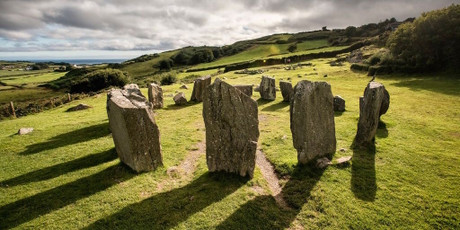Folklore Friday: The Secret History of the Drombeg Stone Circle
Posted by Olivia O'Mahony on 5th Jul 2019
Known for its scenic harbor and popular tourist destination status, the village of Glandore is a highlight location in Co. Cork, lying just over an hour outside of the county city by car. Every year, visitors come in their droves to take in coastal views, participate in the area’s signature sailing competitions, and even try their hand at spotting the whales, dolphins, porpoises, and sharks that occasionally make their presence known offshore.
But just east of Glandore lies its biggest draw by far: about a mile and a half out, there lies a structure so striking that few who have seen it will ever forget its imposing mass. This is Drombeg stone circle, and, backdropped as it is by the rolling fields green fields and strip of distant ocean which lie beyond it, it is magnificent.
DROMBEG: SMALL BUT SIGNIFICANT
Drombeg stone circle is just one of many recumbent stone circles to be found all over the Irish landscape. Like all stone circles, it’s made up of a ring of standing stones, with one particularly large one — known as the recumbent stone itself — lying on its side. With recumbent stone circles, stones are often positioned in order of height, with the size of each one gradually reducing in the lead-up to the horizontal recumbent stone. More Irish recumbent stone circles are found in Cork and Kerry than anywhere else in the country, with the number of structures reaching at least 20 between the two counties. This makes up ten percent of the total number of recumbent stone circles discovered on a global scale.
Despite its relatively diminutive size when viewed in comparison to some of Ireland’s other stone circles, it’s no stretch to say that Drombeg might just be the country's most famous. Though it was originally comprised of 17 stones in total, only 13 remain. Though there has been much debate over the years as to why they were placed in a ring formation, one of the most common theories is that Drombeg stone circle, like many others of its kind, was designed for ritualistic astronomical purposes by Ireland’s Bronze Age occupants.
When the time was right, the moon would have appeared to hang over the central horizontal stone, flanked by the pair at its sides. When this occurred, the polytheistic (or many-god-worshipping) Celts of the era would have had approximately one hour to honor the moon as it passed over the stone. This ties neatly into the scholarly belief that Ireland’s Celtic people were animists who believed that all elements of nature possessed a spirit which could, depending on its treatment by the mortal race, strongly influence the future in either a positive or a negative manner.
Furthermore, astronomers have discerned that approximately every eighteen and a half years, the moon would appear closer than usual, so that it might be “framed” by the two standing stones flanking the recumbent one. It’s theorized that this event would have been a prime time for religious ceremonies, though no one to date has been able to come up with a concrete theory of what these gatherings might have looked like. Of all of the ideas raised within the research community, however, that of Audrey Burl stands the strongest: “The rites enacted in the rings were closely connected with the flourishing and dying of plants, crops, animals, and human beings in the short-lived world of four thousand years ago.” Another popular argument is that Drombeg once marked the crossing point of multiple long-gone underground rivers, which would have been celebrated by the people of the time for their life-giving properties.
Drombeg, which translates from the Irish language to “the small ridge,” is also common referred to as the “The Druid’s Altar” by locals, in good keeping with its ancient and mystical purpose. In the time of the Celts, the druids were a caste of religious specialists who also dealt in magic; though little is known about them today, we can easily surmise that this group were responsible for leading religious processions at stone circles like Drombeg — and arranging the human sacrifices rumored to have been an essential element of each one.
ARCHEOLOGICAL FINDS AT DROMBEG
In 1957 and 1958, a pair of archaeological studies yielded fascinating results, giving legs to the many lines of conversation around Drombeg’s pagan past. Buried near the center of the circle, a broken pot wrapped in thick, sturdy cloth was discovered. Interestingly, testing soon showed that the cracks in the pot seemed to have been deliberately administered — and even more interestingly than that, the dust found inside was soon proven to actually be made from cremated human bones. Further digging on the site saw a multitude of other artefacts unearthed, including 80 additional smashed shards, four pieces of shale, and a collection of sweepings from what experts think to have been a pyre of some sort. Alone, these findings are — to at least some degree — inconsequential; together, they paint a picture of a time long since lost, filling in the gaps in our working knowledge of Ireland’s Celtic communities.
Not far to the west of the circle, the remains of two equally-old stone huts draw the eye on an otherwise lush and verdant landscape. These prehistoric buildings are joined by a common entryway, suggesting that they might have once been owned by members of the same clan or family. Visitors who approach this ground after taking in the sights of the Drombeg circle are usually bowled over by the air of ancient energy that continues to linger; once upon a time, this place was a home, where ordinary people lived ordinary lives.
The smaller of the two huts is attached to an even more exciting treasure of the past: a fulacht fiadh. Still in use in the 5th century A.D., this instrument was used in the cooking of food at its most basic level. The flagged trough at its center was filled to the brim with water, and heavy stones, which had been heated until red-hot over a fire, were dropped in to initiate a boil. While this might sound simplistic or even ineffective, recent tests have confirmed the effectiveness of this cooking method: a group of Irish scientists ran some tests and discovered that the average fulacht fiadh could bring over 70 gallons of water to boiling point in less than 18 minutes, sustaining that same heat for approximately three full hours.
Also worth noting is a 2007 study conducted in Co. Galway, which delved into the question of whether or not the fulacht fiadh could have been used for other, non-carnivorous purposes. Two archaeologists constructed their own version of the device, heating a trough of water to a high temperature before adding barley. After 45 minutes, they transferred it into another vessel with plant flavorings and yeast. There, it began to ferment — confirming the researchers’ suspicions that the people of Bronze Age Ireland could very well have used their fulacht fiadh technology to brew light ale!
Perhaps the greatest aspect of Drombeg stone circle’s appeal is the extent to which it remains uncommercialized as a tourist attraction, even in the fast-moving, profane world of 2019. Visitors to Drombeg are asked to pay no entry fee, but merely that they leave this sacred site in the condition that they found it in upon arriving. It is such behavior, after all, that has allowed Drombeg to remain standing for hundreds, if not thousands, of years; and, more likely than not, that which ensures that it will stand tall as a proud testament to Ireland’s ancient history for many years to come.
******
Have you visited the famous Drombeg Stone Circle? Do you plan to now? Let us know in the comments below!

